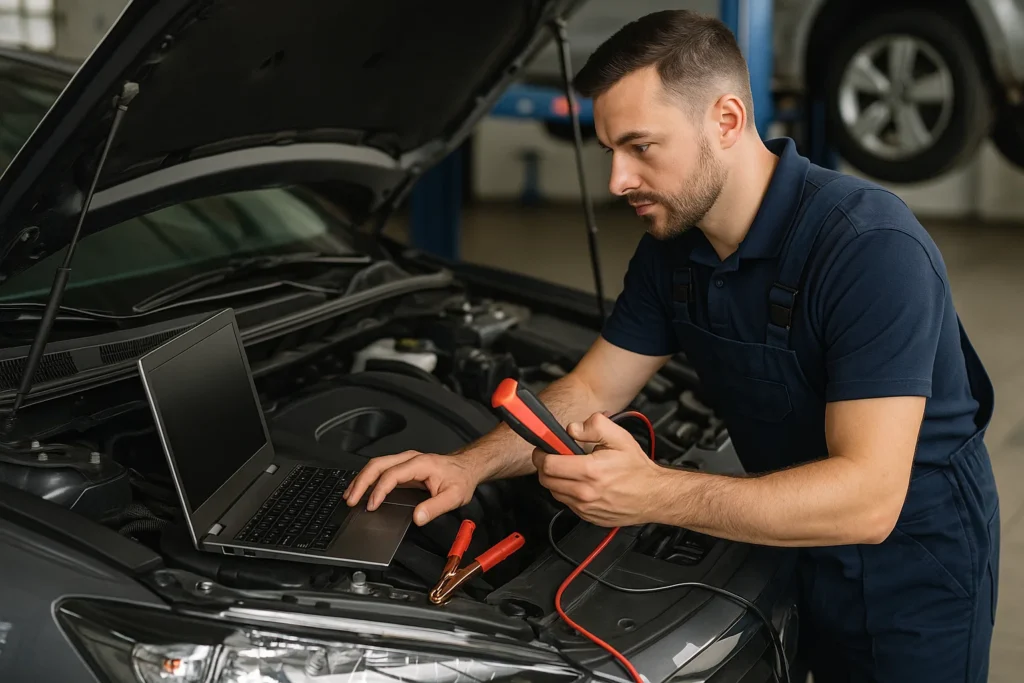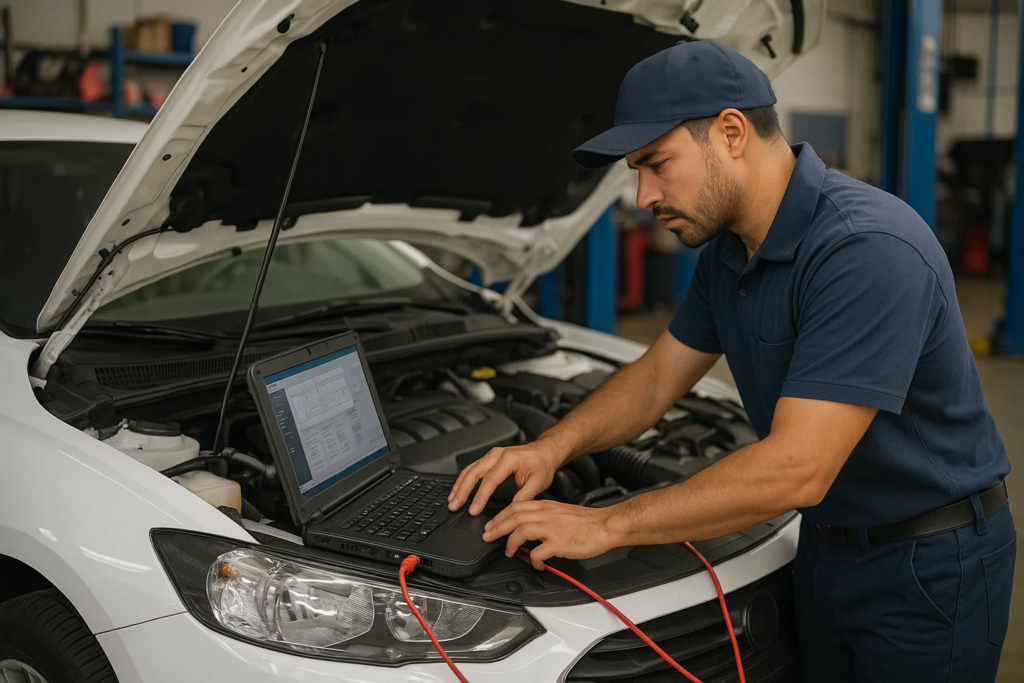
auto technology repair
Welcome to the world of auto technology repair, where mechanics meet machines, and your car’s “check engine” light speaks fluent tech! If you’ve ever wondered how modern vehicles get fixed—or how today’s mechanics keep up with ever-evolving innovations—you’re in the right place.
This guide dives deep into what auto technology repair is, how it’s changing the industry, what tools and tech are involved, and how you can benefit from this futuristic fix-it world. auto technology repair
What is Auto Technology Repair?

Auto technology repair refers to the process of diagnosing and fixing issues in vehicles using advanced tools, computer systems, sensors, and software-based diagnostics. auto technology repair
Gone are the days of purely mechanical work. Now, cars are rolling computers with complex electronic control units (ECUs), integrated AI systems, and data-driven alerts. Fixing them isn’t just about turning a wrench—it’s about reading data, interpreting software codes, and leveraging automation.
Why Has Auto Repair Evolved So Drastically?
There are three main forces behind this evolution:
- Advanced Electronics: From infotainment to engine control, modern cars rely heavily on digital systems.
- Eco Regulations: Green tech like hybrid engines, EVs, and fuel economy systems require specialized tools and updates.
- Consumer Expectations: Drivers want smart features—lane assist, blind spot monitoring, autonomous parking—and repairs must keep pace. auto technology repair
Modern Auto Tech Tools You Should Know
Here are some core technologies shaping the modern auto repair process:
1. OBD-II Scanners (On-Board Diagnostics)
These plug into a port under the dashboard and read codes sent from your car’s computer. It’s like a doctor’s stethoscope for your vehicle. auto technology repair
2. Digital Multimeters
Used to measure voltage, resistance, and current—essential for electrical diagnostics.
3. Oscilloscopes
To visualize electrical signals—especially useful for testing sensors, fuel injectors, or alternators.
4. TPMS Tools
Monitor tire pressure sensors. Vital for modern safety compliance.
5. ADAS Calibration Tools
Essential for fixing systems like adaptive cruise control, lane-keeping assist, or collision avoidance.
Artificial Intelligence in Auto Repair
AI is a game-changer in the repair space. Here’s how it’s being used:
- Predictive Maintenance: Based on mileage, driving habits, and engine behavior, AI predicts part failure before it happens.
- AI-Powered Diagnostics: Some systems suggest repair procedures automatically. auto technology repair
- Chatbots & Virtual Assistants: Customer service tools to book appointments, send reminders, and even give repair estimates. auto technology repair
Electric & Hybrid Vehicle Repairs: A Different Ball Game
Repairing EVs and hybrids requires unique skills and safety protocols.
Key Differences:
- High Voltage Handling: EVs can carry over 400 volts. Safety gloves and insulated tools are a must.
- Battery Management Systems (BMS): These control charging/discharging. Diagnosing battery failure is complex.
- Regenerative Brakes: These systems feed energy back into the battery and require different service methods.
Common Repairs in EVs:
- Battery degradation
- Motor controller faults
- Software glitches in driving modes
Most EVs require less regular maintenance—no oil changes or exhaust repairs.
Training & Certification in Auto Tech Repair
Auto repair is no longer a trade—it’s a high-tech career. Here’s how technicians stay on top of it: auto technology repair
Recommended Certifications:
- ASE (Automotive Service Excellence): Widely recognized in North America.
- EV Certification: Offered by manufacturers like Tesla and Nissan.
- ADAS Calibration Training: For working with self-driving or semi-autonomous systems. auto technology repair
Training Platforms:
- Online courses from Udemy, Coursera, and Automotive Training Authority
- Manufacturer-sponsored programs (Ford, GM, Toyota)
DIY Auto Tech Repair: Is It Safe or Smart?
Great question. Some minor repairs are still DIY-friendly, while others are best left to pros.
Smart DIY Fixes:
- Replacing fuses or relays
- Swapping out air filters or spark plugs
- Using an OBD-II scanner to clear non-serious codes
Leave These to Professionals:
- ECU reprogramming
- High-voltage battery repairs
- ADAS recalibrations
If your dashboard lights up all at once, grab your OBD-II scanner—but call your mechanic too.auto technology repair
Software in Auto Repair: From Firmware to Flashing
Most modern cars require software updates just like smartphones do.
Key Software Services:
- Firmware flashing: Rewriting the ECU’s logic.
- Telematics repair: Fixing systems that connect your car to cloud services or emergency alerts.
- Infotainment debugging: Updating UI systems and fixing bugs.
Technicians often use OEM diagnostic software like:
- Techstream (Toyota)
- IDS (Ford)
- INPA (BMW)
Mobile Auto Repair: Yes, There’s an App for That
Modern car owners have smartphone apps that can diagnose, update, or control vehicle systems.
Popular Apps:
- FIXD: A Bluetooth-enabled diagnostics app
- Torque Pro: For live data and code reading
- Car Scanner ELM OBD2
These tools empower users to get smarter about car health and even save time and money.
Cost of Auto Tech Repairs in 2025
While some tech fixes are costlier due to equipment needs, others are surprisingly efficient.
| Type of Repair | Estimated Cost (USD) |
|---|---|
| OBD-II Diagnostics | $50–$150 |
| ECU Replacement | $500–$1,200 |
| EV Battery Swap | $5,000–$10,000 |
| ADAS Calibration | $300–$700 |
| Software Updates | $100–$300 |
Money-Saving Tip: Regular scans can prevent expensive repairs by catching early issues.
The Future of Auto Tech Repair: What’s Next?
Here’s what the road ahead looks like:
Emerging Trends:
- Augmented Reality Repairs: Glasses that show step-by-step guides over real engine parts.
- Remote Diagnostics: Technicians log into your car’s system from anywhere in the world.
- Blockchain Maintenance Records: Tamper-proof service histories.
- Self-Healing Materials: Some cars will eventually repair cosmetic damage themselves.
The combination of AI, data science, automation, and precision engineering is ushering in an era where cars not only drive themselves but fix themselves too.
How to Choose the Right Auto Tech Repair Shop
When choosing a repair center, consider:
Check for:
- Certified techs (ASE, OEM-specific)
- Modern diagnostic equipment
- EV/ADAS support
- Transparent pricing
- Customer reviews
Avoid:
- Shops without up-to-date tools
- Vague answers or resistance to explain repairs
- No digital service reports or diagnostics
Smart Move: Ask if they offer a printout of your diagnostic scan. It’s your car’s medical record.
Auto Tech Repair at Home: Starter Kit Ideas
If you want to dip your toes into modern car maintenance, here’s a starter kit for beginners:
- OBD-II Bluetooth scanner
- Digital multimeter
- Battery tester
- Tire pressure gauge (digital)
- Repair app subscription (FIXD or Torque)
Even having these five tools can save you a ton in service fees over time.
Key Takeaways: The Roadmap to Smart Auto Repairs
Let’s wrap things up with a recap:
- Auto tech repair combines mechanics with modern software and electronics.
- OBD-II scanners and AI tools help diagnose issues faster and more accurately.
- EVs and hybrids need specialized tools and certified technicians.
- Some repairs can be DIY—but many are best left to trained professionals.
- The future includes AR, AI, and possibly self-repairing vehicles.
Final Thoughts: Fix Smarter, Drive Longer
In 2025, auto technology repair isn’t just about fixing what’s broken—it’s about preventing failure, optimizing performance, and ensuring driver safety through intelligent diagnostics and data.
Whether you’re a car owner or a budding technician, understanding this shift puts you miles ahead. Stay updated, stay curious, and let your car’s technology work with you, not against you.




